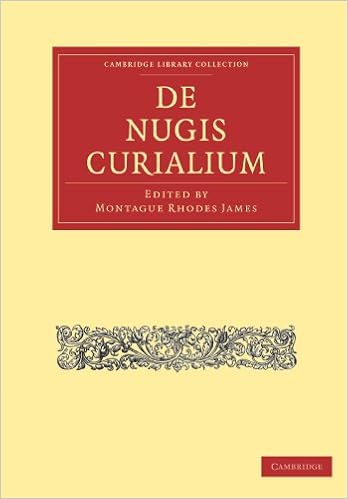Walter Map (Latin: Gualterius Mappus; French: Gautier Map; 1140 – c. 1210) was an English medieval courtier and writer. Map claimed that he was a man of the Welsh Marches. He was probably born in Herefordshire. Map was a courtier of King Henry II of England, working as clerck in the royal household, and as itinerant justice and justice in Eyre. The King also sent him on missions to Louis VII of France and to Pope Alexander III. Map's studies and employment took him to several church services: canon and precentor of Lincoln, parson of Westbury-upon- Severn in Gloucestershire, prebendary of Mapesbury in the Willesden neighbourhood of London, and in later life (1197) Archdeacon of Oxford.
Map wrote De nugis curialium (Tales for courtiers or Courtiers Trifles) between 1185 and 1193. It takes the form of a series of anecdotes of people and places, offering insights on the history of his time. Some are from personal knowledge, and apparently reliable, others represent popular rumours about history and current events, and are often far from the truth. Part 1 of 5 descibes events related to the crusades such as the capture of Jerusalem by Saladin on 2 October 1187, the founding of the Knights Templar by Hugues de Payens with anecdotes of their early years, founding of the Knights Hospitaller, foundation of the Cistercian Order with anecdotes of Stephen Harding, Bernard of Clairvaux and Arnold of Brescia as well as further anecdotes of the Cistercians, Benedictines, Grandmontines and Carthusians.
The writings of Map are not without personal feelings. Map airs his antipathies against Jews, heretics and Cistercians. He recites many terrible instances of the greed and cruelty of Cistercians, whose prosperity he watches with agitation. He hates their leader, St. Bernard (canonized on 18 January 1174), hails him as Lucifer, and records with ill-suppressed satisfaction the failure of his miracles. Mastered by avarice, Templars and Hospitallers are hardly in better case than the Cistercians.
Map describes the story on the foundation of the Templars as follows:A knight called Payns (Pagan) from a district of Burgundy of the same name, came as a pilgrim to Jerusalem. When he heard that the Christians who watered their horses at a cistern not far outside the gates of Jerusalem were constantly attacked by the pagans, and that many of the believers were slain in these ambuscades, he pitied them, and, full of the zeal of right-doing, he tried to protect them as far as he could. He frequently sprang to their aid from well-chosen hiding places and Slew many of the enemy. In indignation at this, the heathen stood on watch in such great numbers that no one could face their assaults. The Christians were therefore forced to abandon the cistern. But Payns, who was neither sluggish nor easy to subdue, obtained, by his prayers, aid for God and himself, and contrived by every possible device to acquire as his own a great dwelling within the enclosure of the Lord’s temple from the regular canons of the temple. Contenting himself with mean garb and scanty food he, under a vow, assumed for his fellows the full cost of horses and armour. By preaching, by prayers, and by all possible ways, he prevailed upon all pilgrims whom he knew to be mighty men of arms to abide in perpetual dedication to God’s service, or at least to live in temporary consecration. He selected for himself and his fellow-knights, in keeping with their arms and their duties, the sign of the Cross and a kind of shield with a distinctive device; and he enjoined upon his companions chastity and temperance.
Text quotes from Tupper and Bladen Ogle (1924): Master Walter Map's Book De Nugis Curialium. The introduction quotes from several lemmas of Wikipedia. The book can be read on internet at Archive.org. Order a printed book: De Nugis Curialium (Cambridge Library Collection - Literary Studies)

No comments:
Post a Comment